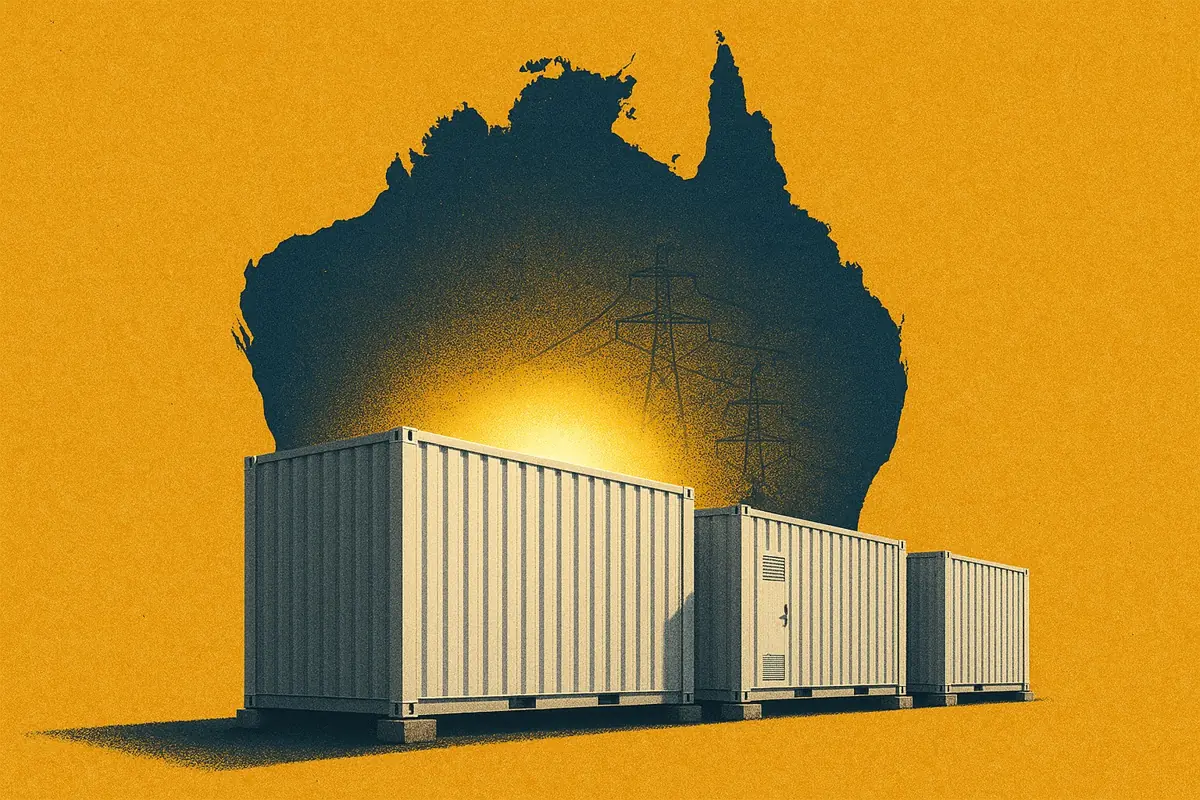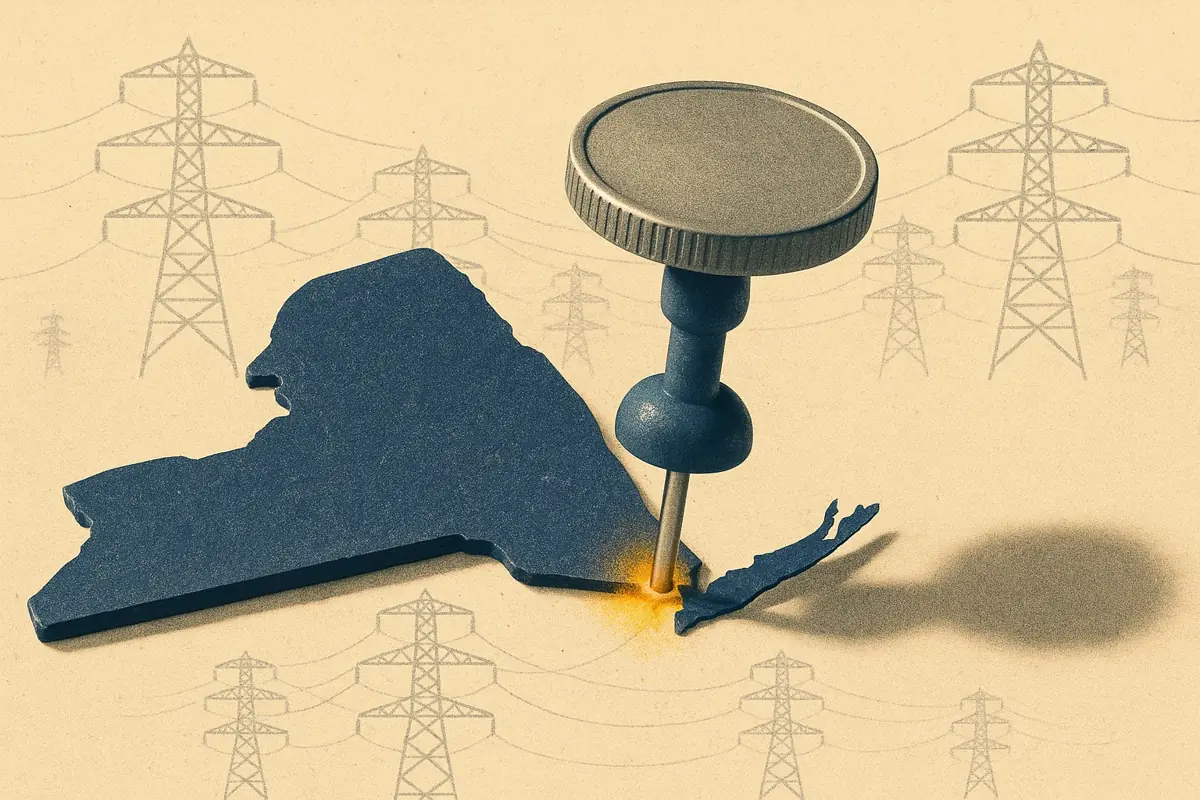This article brings together Modo Energy’s US-focused research and analysis from Q3 2025 - covering BESS revenues, market design changes, buildout trends, and offtake updates across ERCOT, CAISO, PJM, and NYISO.
To summarize:
- Merchant BESS revenues continue to be limited in mature markets: With saturated Ancillary Service markets, batteries in ERCOT and CAISO have needed to rely on market volatility that has yet to materialize in 2025 - average revenues in each region are less than $45/kW-year, year-to-date.
- Load growth resonates everywhere: While revenues in ERCOT and CAISO have been limited in 2025, this has the potential to change if demand grows at even a fraction of recent forecasts. This also impacts markets with less developed storage, such as PJM, where capacity prices cleared at hundreds of dollars per MW-day for the second auction in a row.
- Market design continues to evolve: In ERCOT, the most significant market design change since moving from a zonal to a nodal market will bring increased efficiency to market prices, and will open new opportunities and challenges for BESS operators. Meanwhile, NYISO’s Index Storage Credit opens the door to BESS development in the region.
- Buildout sits at different stages nationwide: Batteries continue to come online rapidly in CAISO and ERCOT, while development remains slow elsewhere. Interconnection queue reforms, the Index Storage credit, and improving revenue opportunities will begin to change this in markets such as PJM and NYISO, however. Meanwhile, the recently passed federal tax bill (the OBBBA) is one of multiple policy headwinds that could potentially stunt deployment in future years.
To keep up to date with all of Modo Energy’s latest insights, sign up for The Weekly Dispatch.
The OBBBA changes project development timeline and CapEx expectations
Where the Inflation Reduction Act (IRA) used federal policy to support the development of Wind, Solar, and Battery Energy Storage Systems (BESS) in the United States, the One Big Beautiful Bill Act (OBBBA) reduces its effect - it accelerates tax credit sunsets and tightens construction and supply-chain rules.
While batteries were shielded from explicit tax credit sunsets, procurement restrictions limit developers’ ability to utilize BESS suppliers local to ‘Foreign Entities of Concern’ and maintain access to the Investment Tax Credit.
Successful developers will act swiftly to secure tax credits prior to the onset of FEOC rules. Developers without the ability to accelerate project timelines will need to carefully consider whether the value of securing tax credits offsets the cost premium of foreign sourcing before determining which supplier to utilize.

Read the full article to further understand the decision points facing developers of wind, solar, and storage here.
How to price a tolling agreement
Securing a long-term offtake agreement is becoming increasingly crucial for new BESS projects obtaining financing in mature markets like CAISO and ERCOT. The market has primarily used traditional physical tolls, but is beginning to move to alternative contract structures as well.
Tolling agreements allow investors to exchange uncertain merchant revenues for predictable contracted cash flows. At their core, these agreements are about achieving a target internal rate of return (IRR).
By forecasting revenues for a BESS and comparing them to the IRR hurdle, a toll price that secures the desired return while still leaving potential upside on the table for the offtaker can be identified.
In ERCOT, there are currently five operating projects under known tolling agreements, with seven additional tolled assets expected to come online by the end of 2026.
For more on the state of the offtake market in ERCOT, click here. To learn more about how to think about pricing offtake agreements, continue reading here.
Why Wind and Solar generators can’t get by with just a Power Purchase Agreement
As the total installed capacity of wind and solar generation has grown in ERCOT, the average price at which wind and solar sell energy - or the ‘capture price’ - has fallen.
In 2025, this value sits at around $17/MWh for both technologies, at the bottom end of the levelized cost of energy - the price at which a technology must sell energy over its lifetime to earn a profit.
However, Power Purchase Agreements (PPAs) reduce the reliance on a high capture price.
Like tolling agreements for battery energy storage, PPAs offer wind and solar projects a route-to-market through an off-taker.
The off-taker provides steadier, risk-adjusted returns - allowing developers to access lower-cost capital to finance and build projects - by agreeing to pay a flat value for each MWh produced by the generator.
However, a key reason why capture prices for wind and solar resources have fallen in recent years is increased curtailment. As more wind and solar generation has come online, transmission lines across ERCOT are more frequently at risk of being overloaded, and as a result some of this generation is curtailed.
When ERCOT directs a generator to curtail its output to maintain grid reliability, this curtailed energy is not delivered and therefore not paid under the PPA.
Curtailment is one of the biggest challenges PPAs do not solve - projects are not paid for the energy they don’t produce.
One of the ways for resources to potentially alleviate the curtailment concern - at least for solar generators - is to co-locate with battery energy storage.
Co-located battery energy storage systems shift solar energy past sunset - improving revenues in two ways.
First, it allows sites to sell energy during peak prices by charging the battery during periods of excess solar generation and low prices.
Secondly, it provides sites with flexibility on their output, allowing them to contract shaped base-load PPAs that extend past sunset. This improves overall returns for selling energy under contract.
While this article was written based on ERCOT data, the insights apply to all regions of the US.
Read more about curtailment here.
Benchmarking BESS revenues with top-and-bottom spreads
Top-Bottom (TB) spreads serve as a benchmark for the revenue that a battery can earn from energy arbitrage. By comparing TB spreads across durations and locations, stakeholders can identify optimal strategies and sites for battery energy storage deployment.
When Ancillary Services become saturated with battery energy storage capacity - like in ERCOT and CAISO today - energy arbitrage composes the vast majority of merchant revenues for batteries.
A TB spread is a simple but powerful way to quantify this opportunity. It measures the difference between the highest and lowest electricity prices on a given day.
- A TB1 spread is the highest hourly price minus the lowest.
- A TB4 spread is the sum of the four highest hourly prices minus the four lowest.
TB spreads offer diminishing returns as duration increases. TB1 captures the most lucrative opportunities by reflecting peak price volatility, while each subsequent hour adds progressively less value.
Markets like ERCOT, which lack a capacity market, tend to exhibit more price volatility compared to regions like PJM that rely on more structured market mechanisms.
In ERCOT, optimizers are now being tested on their ability to extract value from the volatile Day-Ahead and Real-Time energy markets.
Capture rates are becoming an increasingly important metric as arbitrage contributes a larger proportion of the revenue stack.
Capture rates measure how close a battery comes to some definition of “perfect” performance. They’re calculated by dividing revenue by a theoretical maximum. In this analysis, that ideal measure is defined using Real-Time Top-Bottom (TB) price spreads.
The maturation of the ERCOT market has formed a new landscape for batteries. Consistently high capture rates are now harder to achieve as lucrative alternative revenue streams have become less accessible.
To learn more about how to utilize TB spreads to understand BESS revenue opportunities, and what spreads looked like across various US ISOs so far this year, click here. Read on here to learn about how TB spreads can be applied against actual revenues to determine a ‘capture rate’, and how optimizers of batteries in ERCOT have performed in 2025 when using capture rates.
Demand growth is coming, but how much is realistic?
In April 2025, ERCOT revised its outlook for future load growth to include 35 GW of peak demand from Data Centers by 2035 - a number that is nearly half the current system peak.
This shift is part of a wave hitting power systems nationwide. Technology giants are descending on states like Texas and Virginia to build hyperscale Data Centers en masse, drawn by reasons such as inexpensive power supply, abundance of land, or proximity to critical demand centers for compute.
PJM’s 2025 outlook projects peak demand climbing from 160 GW to 210 GW by 2035. This projected growth is almost entirely due to the continued buildout of data centers.
But the realities of connecting to the power system aren’t quite so simple.
How fast can growth actually go?
Constraints such as limitations in how quickly supply can grow to serve new demand or bottlenecks in the supply chain for pieces of critical infrastructure like chips, transformers, or even land will prevent demand growth from being as fast as the baseline forecasts from ERCOT and PJM would indicate.
Continue reading to learn more about Modo Energy’s view on how much demand growth is actually feasible in ERCOT and PJM. For more information about PJM’s recently introduced Non-Capacity Backed Load proposal that would provide an alternative to allow more data centers to connect to the grid, click here.
Insights by US ISO
ERCOT
BESS revenues have declined further in 2025, from the already all-time low figure of $55/kW-year in 2024. Year-to-date, the average battery has earned revenues of just over $30/kW-year in ERCOT.
This has been driven by the continued saturation of Ancillary Services. In addition to shrinking opportunity in Ancillary Services, 2025 has had minimal volatility in energy prices, as batteries continue to offer more competitively into ERCOT’s Day-Ahead and Real-Time Markets, while weather conditions have been more in line with historical norms than in 2022 and 2023.
Find more about BESS revenues in ERCOT within each of our monthly BESS revenue benchmark reports:
Another key change coming to the ERCOT market is the implementation of Real-Time Co-Optimization. RTC+B - the ‘B’ is for batteries - goes live on December 5th, 2025.
RTC+B will reshape how batteries compete for Ancillary Services and how they manage their positions in the Real-Time Market, as Ancillary Service procurement will move from being solely procured in the Day-Ahead Market to clearing in both the Day-Ahead and Real-Time Markets.
The shift will improve overall market efficiency while creating new opportunities and challenges for batteries.
Batteries will have more flexibility to move between Energy and AS positions in Real-Time, but will also face tighter restrictions on state-of-charge (SoC).
For more information about why RTC will be the biggest market design change in ERCOT in more than a decade and how BESS can be best prepared, click here.
Other key highlights from Q3:
- BESS buildout hits 10 GW of commercially operational capacity by rated power, and 15 GWh by energy capacity
- Though revenues have been at all-time lows in 2024 and 2025, what’s changing that could improve the outlook for batteries and their investment case in the coming years?
- As revenues are increasingly earned through energy arbitrage and across more hours of the day, are four-hour batteries becoming more investable?
CAISO
In CAISO, merchant BESS revenues have also stagnated. Through September of 2025, the average battery in CAISO earned $32/kW, or $42/kW-year when annualized.
This represents a decline from $80/kW-year and $51/kW-year in 2024 and 2023, respectively. This shift is for the same reasons as in ERCOT - saturating Ancillary Services, and battery energy storage Energy offers that are increasingly competitive.
As the growth of BESS dispatch occurs during the day at increasingly competitive prices outpaces the growth of installed solar capacity and peak demand, the price curve for Energy begins to flatten.
However, BESS revenues in CAISO aren’t exclusively on the decline. Contract prices for resource adequacy have consistently risen year-over-year throughout the decade.
With a Resource Adequacy contract in place, the average battery could still have earned total wholesale revenues of nearly $14.83/kW-month, or $178/kW-year, on average, thus far in 2025.
Find more about BESS revenues in ERCOT within each of our monthly BESS revenue benchmark reports:
Other key highlights from Q3:
- CAISO’s Flexible Ramping Product is tailored to BESS, but opportunity is limited
- Total installed BESS capacity now stands at more than 50 GWh, with an expectation of more than 20 GW and 75 GWh by the middle of next year
- CAISO’s Extended Day-Ahead Market is nearing implementation, here’s how it will function
PJM
In PJM, batteries are a much more nascent technology than in more mature markets like ERCOT and CAISO. Less than 450 MW of BESS capacity is commercially operational across the largest de-regulated power market in the US.
This has largely been a result of an interconnection queue that has been bogged down with requests in recent years - projects of all technology types have been largely unable to connect to the grid this decade.
However, this is set to change in the coming years. PJM’s interconnection queue reform and a capacity market clearing at prices that would enable BESS revenues in excess of $75/kW-year multiple years in a row are clearing a path for BESS development to take off.
The first phase of projects to come out of the queue reform is set to yield more than 4 GW of installed capacity in PJM by the end of the decade.
Find out more regarding PJM’s interconnection queue reform and the BESS projects it is set to yield in the coming years.
Other key highlights from Q3:
- PJM’s Ancillary Services: A beginner’s guide
- How do resources get paid for providing Regulation in PJM?
- What does PJM’s capacity market clearing at all-time high prices mean for BESS?
NYISO
Similarly to PJM, while less than 300 MW of battery energy storage capacity is operational in NYISO today, the rest of the decade is likely to see a steep upslope in buildout.
In New York, this is largely a product of the Index Storage Credit (ISC) program. The program was created to address revenue uncertainty for BESS developers, with a goal of resulting in 3 GW of grid-scale BESS coming online in the state by 2030.
Each month, ISC contracts will require the New York State Energy Research and Development Authority (NYSERDA) to cover potential shortfalls between a Reference Price and Strike Prices for contract holders.
Strike Prices are determined based on bids submitted by battery owners when applying for ISCs and is generally representative of a target revenue threshold for a project. The Reference Price is calculated on a monthly basis to estimate the average potential daily revenue for batteries in each zone.
However, because of how the Reference Price is calculated, a battery can earn wholesale revenues that are higher or lower than the Reference Price.
For more about the structure of the Index Storage Credit program and the state of BESS development in NYISO, click here. To learn how battery developers can make the most of how the Index Storage Credit is designed, read more here.







